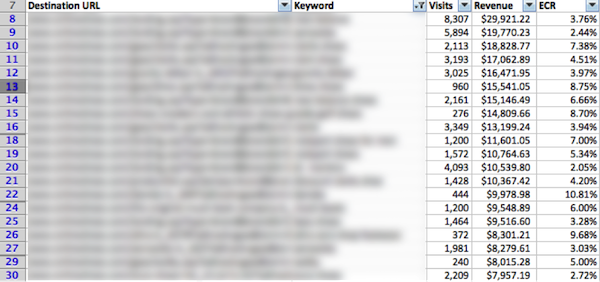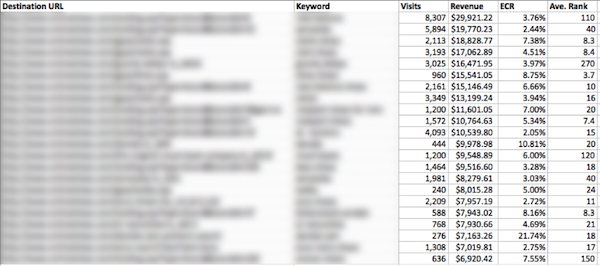We can no longer precisely track traffic for Google in organic search at the keyword level. As “(not provided)” creeps its way up to 100 percent, so does the lack of our ability to track Google organic keyword conversions.
Tell your friends, family, loved ones, the boss. Then if you haven’t immediately lost their attention with the use of acronyms and jargon, also let them know that we’re still able to measure our efforts and gain strategic insight in many ways.
This article is an attempt to explain what we see in keyword reports currently, show how PPC data can help guide SEO efforts, and finally a consolidation of initial thoughts and ideas to assist in moving forward.
Smart SEO professionals will still prove their worth. Together we can overcome this daunting hurdle.
What Do We See in Google Organic Keyword Reports?
Short answer: We aren’t seeing an accurate representation of keywords people are using to get to our sites.
The easiest way to look at this is by visualizing the browser versions that are still passing keyword referral data.

Above, the light green color is the percent of keywords that are still passing keywords next to the darker Google organic visits.
In essence, we’re mostly seeing keywords from outdated versions of Safari and MSIE (Internet Explorer). So the search behavior associated with the demographics using outdated browsers is what we see coming from Google in analytics packages like Google Analytics. Probably not a comprehensive picture into what is actually happening.
Using PPC Data to Guide SEO Strategy
Google needs marketers to be able to quantify their efforts when it comes to AdWords. Therefore, keyword data is passed and there to take advantage of.
The thought here is that if a page performs well in a PPC campaign, it will translate to performing well at the top of organic listings, though people clicking ads versus organic listings probably behave differently to some degree.
There are many ways PPC data could be used to help guide SEO strategy, this is just one to get the juices flowing.
Step 1: Identify Top Performing PPC Landing Pages
If using Google Analytics, from Dashboard click Acquisition > Adwords > Destination URLs. Assuming you have sufficient conversion tracking set up here, it should give you all the information you need to understand which pages are doing the best.
After filtering out the homepage, sorting by the conversion metric of your choice, adding Keyword as a secondary dimension, then exporting 100 rows you will have the top performing 100 landing page/keyword combinations for PPC. Revenue is always a good indication that people like what they see.

Step 2: Pull Ranking Data
Next, pull in Google Webmaster Tool Ranking data for the associated keywords. You can access this data in Google Analytics from Dashboard > Acquisition > Search Engine Optimization > Queries, or in Google Webmaster Tools.
Specify the largest date range possible (90 days) and download the report. Then use VLOOKUP to pull in ranking data into the spreadsheet containing the top PPC landing page/keyword combinations.

Now that we know where our site shows up in organic for the top PPC keyword/landing URL combinations, we can begin forming strategy.
One obvious strategy is to make sure that the PPC and organic landing pages are the same. Sending PPC traffic to organic canonical pages can only increase the possibilities of linking and social sharing, assuming the organic page converts well.
Another option is to filter the Average Rank column to only include first page rankings, in an attempt to identify low-hanging fruit. Once an opportunity is identified, compare SEO metrics to determine where focus should be placed and how best to meet and beat your competitors.
Additional Thoughts on SEO Strategy in a 100% ‘(Not Provided)’ World
1. ‘(Not Provided)’ Still Counts as Organic
Conversion information is still applied to the organic channel, don’t forget! We no longer have the ability to say someone who Googled [hocus pocus] bought $1,000 worth of “hocus pocus” stuff. But we can say that someone clicked an organic listing, landed on the hocus pocus page, and bought $1,000 of stuff.
Note: “(not provided)” shouldn’t be confused with the issue of iOS 6 organic traffic showing up as direct. Last we checked this was hiding about 14 percent of Google searches, but is becoming less of an issue with the adoption of iOS7.
2. Bing Still Has Organic Keyword-Level Tracking
Bing doesn’t use secure search, so we can still see what people are searching to get to our sites, conversions, sales, etc. Bing data could help quantify SEO efforts, but it’s still only 9.1 percent of organic search share.
Note: People searching Bing versus Google probably behave differently to some degree.
3. Google Webmaster Tool Search Query Data Provides Partial Insight
Google gives us access to the top 2,000 search queries every day. After understanding limitations, the search query report can be invaluable as it gives a glimpse of how your site performs from Google’s side of the fence. Google also recently mentioned they will be increasing the amount of data available to a year!
By linking Google Webmaster Tools with AdWords, Google also has given us a report using the same search query data except with more accurate numbers (not rounded).
Conclusion
Clearly, page-level tracking is more important than ever. Google has forced SEO professionals to look at what pages are ranking and where, and then pull in other sources to guess on performance and form strategies.
Google will most likely respond to the outcry by giving us access to more detailed search query data in Google Webmaster Tools. As mentioned before, they have already announced an increase of data from 90 days to a year. This may be a sign of how they might help us out in the future.


